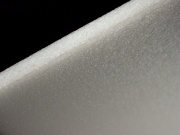Difference between revisions of "Closed cell foam"
Jump to navigation
Jump to search
(username removed) |
|||
| Line 2: | Line 2: | ||
== Description == | == Description == | ||
| − | A dense, durable [ | + | A dense, durable [[foam]]. Closed cell foams have unconnected air cells that are formed by incorporating gas bubbles into the structure of the foam. This can be done mechanically by mixing in the bubbles or a low-boiling [[solvent]] into the [[polymer]] prior to curing, or chemically by adding a blowing agent that evolves [[gas]]. |
== Additional Images == | == Additional Images == | ||
Revision as of 10:18, 13 January 2014
Description
A dense, durable Foam. Closed cell foams have unconnected air cells that are formed by incorporating gas bubbles into the structure of the foam. This can be done mechanically by mixing in the bubbles or a low-boiling Solvent into the Polymer prior to curing, or chemically by adding a blowing agent that evolves Gas.
Additional Images
Authority
- Pam Hatchfield, Pollutants in the Museum Environment, Archetype Press, London, 2002

